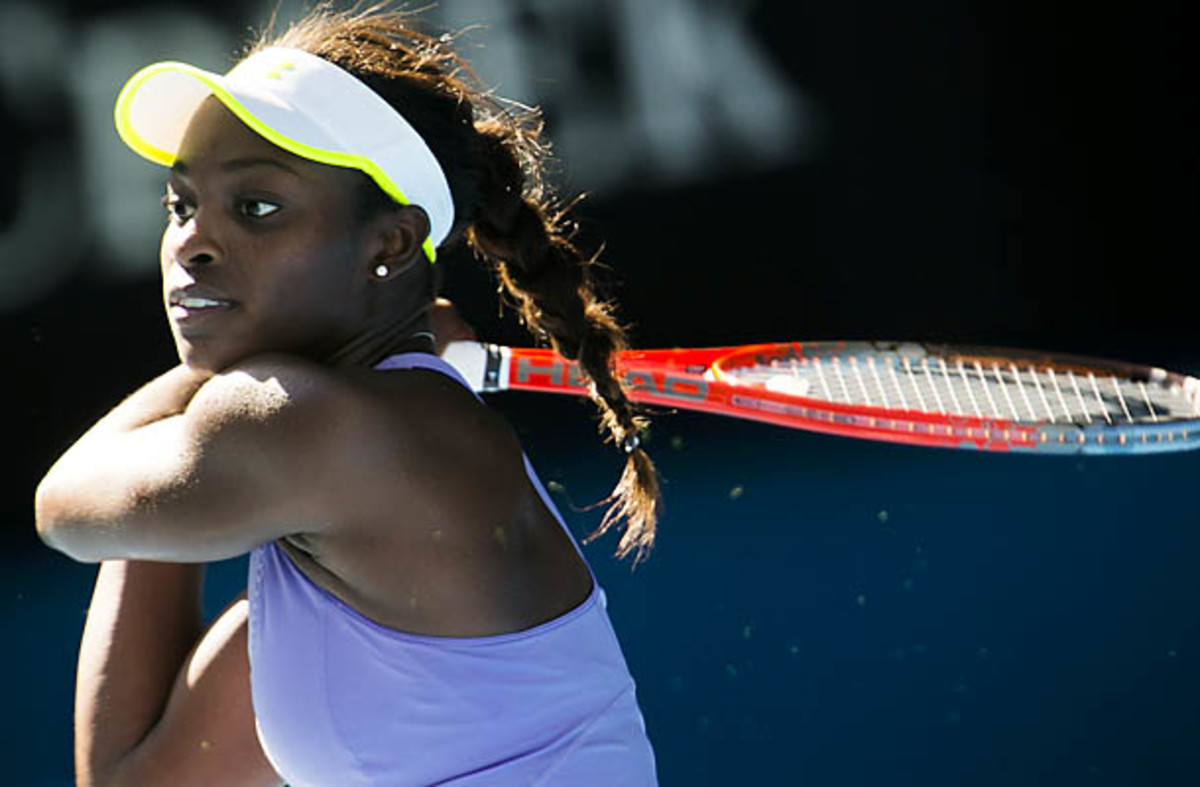
American history: How Sloane Stephens compares to past U.S. teen breakouts
Sloane Stephens moved into the top 20 with her semifinal run in Australia. (Asanka Brendon Ratnayake/Icon SMI)
It had been a long time since a young American made as big a splash as Sloane Stephens did at the Australian Open. Not only did she hand Serena Williams her first career loss to a younger American, but the 19-year-old also became the first U.S. teen to reach the semifinals of a Grand Slam tournament since a 19-year-old Serena at the 2001 U.S. Open. This week, Stephens hit another milestone, becoming the first American teenager to make her top-20 debut since Williams in 1998.
Those results, combined with Stephens' engaging personality and precocious nature, mean that the spotlight is shining a few hundred watts brighter. She's already done a measured post-tournament media blitz, appearing on CNN and The Ellen Degeneres Show this week.
So how does Stephens compare to some of the other recent breakout American women?
Alexandra Stevenson: One name kept coming up as Stephens made the semifinals in Melbourne, though it was whispered in the dark corners of the Internet rather than bandied about in broad daylight on ESPN. The comparisons between Stevenson and Stephens were easy and useful in keeping expectations in check. Both have famous pro-athlete fathers -- Stevenson is the daughter of NBA legend Julius "Dr. J" Erving, while Stephens' late father, John, was a Pro Bowl running back for the New England Patriots. Both were teens when they made the semifinals at a major, with Stevenson getting to the Wimbledon final four as an 18-year-old qualifier in 1999. Both lost to the eventual champion, Stevenson to Lindsay Davenport and Stephens to Victoria Azarenka.
Unfortunately for Stevenson, that would be the only notable result of her career. She cracked the top 20 a few years later, but she never won a WTA title or made it past the second round of any other Slam. Injuries hampered her career, and while she still plays today at 32, she hasn't competed in the main draw of a Slam since 2004.
But barring any major injuries down the road, there's little reason to believe that Stephens will follow the same career arc. She's already had better overall results than Stevenson at this stage in their careers, and Stephens' defensive ability means she'll always be able to hang in matches even when she's misfiring. While Stevenson was blessed with power, she didn't have a B-game that could help her grind out matches.
Melanie Oudin has been quiet since her 2009 U.S. Open quarterfinal run. (Simon Bruty/SI)
Melanie Oudin: The most recent cautionary tale in American tennis, Oudin's run to the quarterfinals of the 2009 U.S. Open as a qualifier stands as one of the most impressive strings of wins by an unseeded player at a Slam. At 17, the diminutive Georgian beat Anastasia Pavlyuchenkova, fourth-seeded Elena Dementieva, 29th-seeded Maria Sharapova and 13th-seeded Nadia Petrova before losing to Caroline Wozniacki.
She's struggled since. Oudin, 21, blames the pressure and expectations that grew out of that summer. She came to resent the idea that she was supposed to replicate that success every week. She went from a career-high No. 31 to outside the top 200. She recommitted herself last year and moved her training base from Georgia to the USTA center in New York and saw immediate results, even winning her first WTA title, in Birmingham, England, last summer.
While I've never really bought into the idea that the media sold Oudin as a future top-10 player immediately after her career-defining U.S. Open (in fact, I'd venture a guess and say most tennis insiders saw that run as a triumphant example of overachieving), I'm sure there were pockets that did, and Oudin clearly internalized that. From a pure tennis standpoint, Stephens has more upside in her game than Oudin, with more natural power and movement and a big serve that she can continue to hone. But as we saw with Oudin, the perceived pressure to win can be crippling. We have yet to see how Stephens will handle it.
Christina McHale: She's struggled since contracting mono last summer, but I'm including McHale in this list mainly because of her workmanlike effort in getting her ranking up and becoming the American No. 2 as a teenager last year. She did not post head-turning results at the Slams, but by notching some significant scalps at the big WTA tournaments, next thing you knew she was No. 24 last summer.






